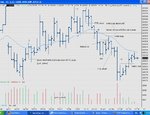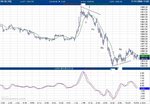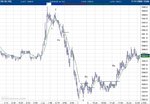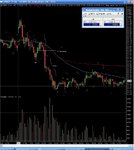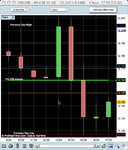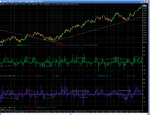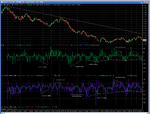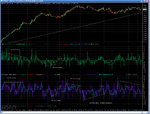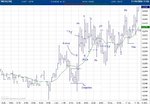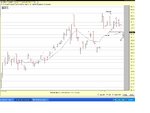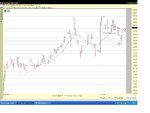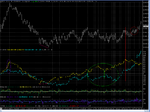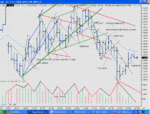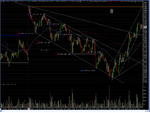Rough delta notes -
Terminology:
Aggressive: Orders to buy the ask or sell the bid. e.g Market, limit and stop.
Passive: Orders to buy the bid or sell the ask. e.g Limit.
Market rises when: Aggressive buy orders eat the whole ask; passive sell orders are pulled from the book until the ask is zero
Market falls when: Aggressive sell orders eat the whole bid; passive buy orders are pulled from the book until the bid is zero.
Aggression shows the highest level of immediate conviction
Aggressive orders may be losing positions getting out at any price (stops).
Effort: Trading activity, i.e. volume.
Velocity: Speed of price change with respect to time. (consensus only momentary)
Acceleration: Rate of increase or decrease in velocity.
Result: Price change for given measure of time or effort.
Effort encompasses: Aggressive effort; passive effort when it meets the former and a trade ensues;
Effort to achieve certain result by aggressive participants can be reduced if passive orders are pulled or increased if they are added.
Professionals will be one, the other or both depending on context.
Amateur more likely to be aggressive (must be when price hits their stop)
Agg paricipants have more conviction but it may be misplaced. Agg. more easily dissappointed if results don't meet expectations?
Agg. in high velocity moves may be late whereas pass. are already in and/or more patient?
Pros may be agg. if they can see it might squeeze an amateur or make him show his hand.
Net delta shifts accompany moves as one would expect. Everyone starts eating the ask and we go up. But do they precede them too, on occasion?
Have also observed bars (usu. time bars) often during pullbacks with heavy bid volume at one end and heavy ask volume at the other that lead to a big move ... possibly due to large positions having been taken (during a fierce battle) followed by rush to cover when it goes wrong way?
Aim: Study level of aggressive ask and bid trades and their effect on price.
Use fixed unit of volume per bar of price change because effort viewed over fixed units of time tends to be irregular e.g far fewer contracts traded in a lunchtime minute bar than one just after a Fed decision. I am standardising the unit of effort because I want the measurement of agg/pass to refer to a reasonable and fixed sample size. (Time) bars containing virtually no effort can give spurious results. e.g a bar in which 6 lots traded at the ask and 1 at the bid is not very useful when the one before traded 300 contracts.
Chart study:
Fixed volume bars, e.g 500 lots
Ask volume per bar
Bid volume per bar
Price change per bar
Cumulative ask volume per day
Cumulative bid volume per day
possibly -
price change / % ask volume (up closes - per bar or day)
price change / % bid volume (down closes -per bar or day )
Latter represents result / effort. What was the level of aggression? To what degree was the aggressors' view confirmed or rejected in light of this? Ease of movement or not? Within context was it a sudden successful or failed campaign or was the status quo maintained.
Split delta into say <10 lots and >10 lots. Does size do summat different to minnow? Is size generally wiser, assuming most size has earned the right to swing it?
Doubts: Is there any real point in making this distinction? Agg/pass ... motive ... whatever ... all that matters is overall effort and result which can be seen in any normal chart. Is it wise trying to distinguish amateur from professional money given the wealth of reasons for trades at any level by anyone .. hedging, arbs, fundamental, scalpers, value / momentum etc.. Do the "pros" and "amateurs" really form discrete groups that consistently do different things at key levels, pre/during breakouts, pullbacks etc.? Do the pros really use their size and skill to test the amateurs volition to enter or exit at certain levels? Information overload - what's wrong with simply following price alone? Unexciting Ross Hooks, 123s, breakouts etc. work if MM is sound. Is the whole attempt at understanding (hidden/overt) condition/cause/effect in the market largely pointless or does it represent the pinnacle of trading? I scalp okay with feel & a few standard crutches, so why not just accept this, size up and stop looking for more clues? The market does not work on fixed mathematical rules. Searching for definable edges is futile in the long term. Thought process beyond a certain level of complexity cannot be programmed. However further kernels of information can still help if one knows how to apply them fluidly.
Future wild gosling chases:
Examine order book delta, i.e % of cumulative ask or bid volume divided by total volume in book
.
Could this be useful?
e.g Heavy ask volume = passive participants think price will rise a few points very soon but not longer term?
While others will see the relatively heavy overhead supply and be wary of buying. Or perhaps they just have - just enough of them for the final flurry to hit those patient, passive asks.
Grr for every thought there is an opposing one that seems to make examination pointless or horribly misleading. Charts start Monday


